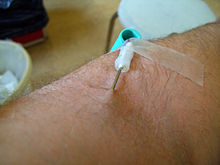Whole blood donation
When whole blood is generally the blood associated method in which most 500 ml of blood from an arm vein be removed.
In contrast to apheresis , all parts of the blood are removed. The technology required is relatively simple and uncomplicated, which is why this form of donation is used particularly for "overland appointments" (removal team comes to the gym, school, etc.).
In detail, multi-bag systems are mostly used today, which are supplied sterile and never opened - if you ignore the needle. The first bag picks up the blood directly from the arm vein. In the associated institute, the bag is hung so that the blood flows through a filter following gravity (this removes the leukocytes ) and is collected in the next bag. The whole blood is centrifuged in this bag, whereby the erythrocytes settle down due to their greater weight and the blood plasma remains above it. These products are now generally ready; When the associated tests have been completed (ie it is known that the blood is "without pathological findings" (op B.)), it can be given to hospitals (erythrocytes) or to industry (plasma).
Modern collection sets also allow the extraction of platelets , for which the platelets, which would be disposed of with the so-called " buffy coat " after centrifugation in the method described above, are pooled from four donors of the same blood group .
